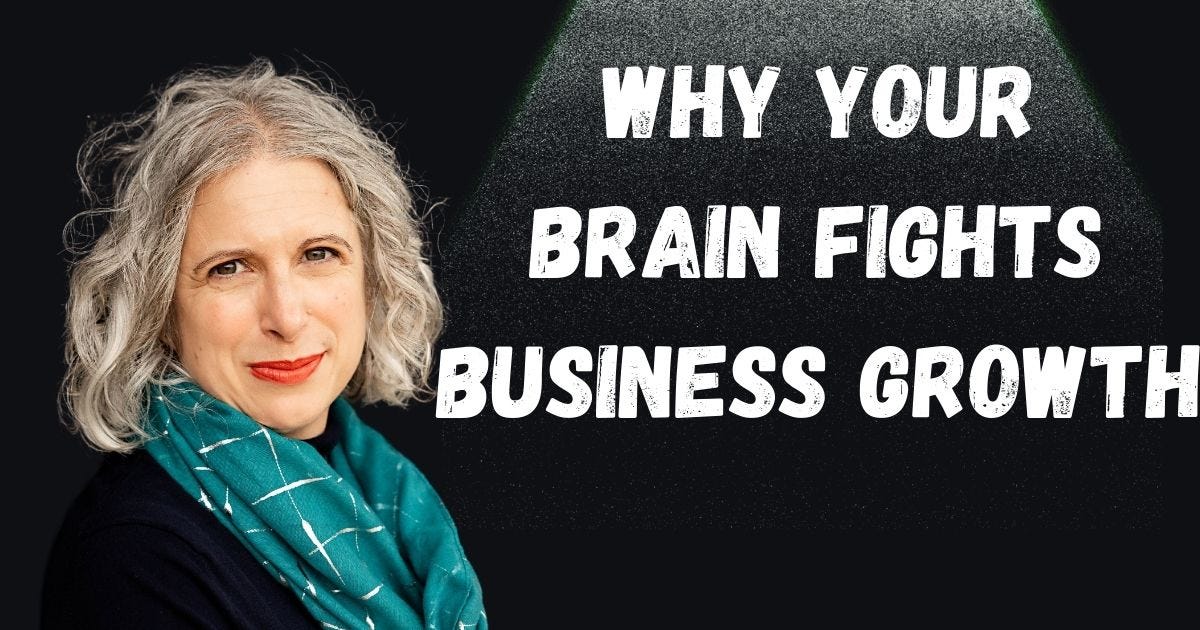Welcome to a free edition of Start Up To Grown Up: Your source for ideas, insights and tactics to take back control of your business and scale it sustainably and profitably by Heather Townsend, award-winning author of The Accountants’ Millionaires’ Club and Founder of The Accountants’ Growth Club
Feeling stuck? You’re not alone
I’ve been there myself.
Too many times.
I’ve created the spreadsheets and business plans that I believed would rapidly grow my business. And in the process allow me to drop down my working hours and enjoy financial freedom. Only to then find out that my business, at best, limps along. Even worse, I’m still working long hours.
And I know I am not alone. Why did you start your business? I bet at some point you had big ambitions for it. Whether that was financial freedom, control over your time, or a business that grew profitably, steadily and sustainably.
But at some point, like me, you’ve probably hit a wall. After all, it can be soul destroying not to achieve your goals, no matter how much time, energy, and money you pour into your business. Then the crippling belief starts creeping in:
Maybe I just don’t have what it takes.
If that sounds familiar, I want you to know something important. Your brain is the problem but not the enemy. The belief that change is impossible - after all, you are who you are - isn’t reality; it’s just a well-worn neural pathway firing in your brain. And the good news? That pathway can be rewired.
The ability to shift from “this is impossible” to “I can make this work” isn’t about “faking it until you make it” or forcing yourself to “think happy thoughts.” Nor is it doing a 30 minute meditation followed by journalling every morning. It’s about understanding how your brain processes failure, fear, and motivation. And then using that knowledge to create real, lasting change.
The big challenge when scaling your small business isn’t necessarily the ability to grow your top line or find good employees. It’s the fact that, as CEO, your role and identity is changing as your business grows and scales. That often means what got you to this point is likely hindering you from taking your business to the next level. That means you need to shift your identity, mindsets and beliefs if your business is ever going to evolve from a permanent teenager into the mature adult it needs to be.
Why our brains resist change
Your brain is designed to keep you safe. However, what your brain perceives as safe today is the same as it was hundreds of thousands of years ago. I.e. back in primitive times when sabre tigers were a big threat to our existence. That’s why, when faced with uncertainty, doubt, fear or risk, your amygdala (the brain’s fear centre) sounds the alarm, triggering stress responses like self-doubt, procrastination, and avoidance.
The more times you’ve tried and failed, or the more you’ve told yourself that something isn’t possible, the stronger these neural pathways become. Your brain essentially “wires in” the belief that success is out of reach, making it feel like an absolute truth rather than just a thought pattern. We all have these beliefs that there is something we can’t do. For example, I am working hard to push against the thought that I am not structured and can’t follow my own plans. There is - let’s just say - a lot of evidence to suggest that this may actually be true.
On top of that, your brain is the most energy hungry organ in your body. As a result it tries to work efficiently. This means it prefers repeating familiar patterns, such as habits, behaviours and beliefs because these require less energy. If you’ve been operating with the same mindset for years, your default neural circuits are set up to reinforce that way of thinking; even when it’s unhelpful.
So, if you’ve been feeling stuck, it’s not because you lack ability or potential or that you can’t grow and scale your business. It’s because your brain is following an old roadmap. The challenge now is to redraw that map.
Rewiring your mindset: How neuroplasticity works
The key to change lies in neuroplasticity; your brain’s ability to rewire itself based on repeated thoughts and behaviours. Your brain lays down neural pathways every time you do something. And because it likes to be efficient, it prefers to follow an existing pathway, reinforcing it each time. To break this cycle, you need to consciously challenge your brain to act differently rather than relying on autopilot. Every time you confront a limiting belief and behave differently, you weaken the old neural pathway and start forming a new one. While you can never completely remove the old pathway, you can build a stronger new one so that your brain defaults to it instead.
Think of it like walking through a forest. If you always take the same path, it stays clear and easy to follow. But forging a new path takes time and effort. Especially if it doesn’t yet exist and you have to push through brambles and muddy ground. Step by step, day by day, the new pathway forms and becomes easier to follow. While the old pathway gradually becomes overgrown, making the new one the default route.
This is how real mindset change happens. It starts with a conscious desire to change, followed by consistent actions that reshape how your brain processes challenges and opportunities. What doesn’t work - despite what social media adverts claim - are sudden epiphanies or quick hacks. After all, we are who we are, and when it comes to our brains it’s a journey of evolution rather than revolution.
Science-backed strategies to shift a stuck mindset.
Now that you know mindset change is possible, here’s how to start making it happen.
1. Catch and challenge negative thought loops
Most people aren’t even aware of the automatic thoughts holding them back. After all, they are typically automatic and who has the time to stop and properly reflect? Thoughts like:
“I’ve tried everything, and nothing works.”
“I’m just not the type of person who can be successful.”
“If I raise my prices, I’ll lose all my clients.”
These thoughts feel real because they’ve been repeated so many times. Plus your business performance to date might seem to confirm them. But that doesn’t make them true.
Use the “Take a Thought to Court” technique:
Write down a limiting belief.
Look for evidence that supports it.
Now look for evidence that contradicts it.
Rewrite the thought in a way that’s both true, but also challenges your negative mindset.
For example, instead of “I’m bad at people management,” try: “I haven’t mastered managing people yet, but I can learn the techniques needed so it feels more natural to me”
This process weakens old neural pathways and starts creating new ones based on possibility rather than fear.
2. Reframe failure as a learning opportunity
Your brain treats failure as a threat. After all, who likes being a failure. Particularly as social media is full of the edited highlights of others’ lives. But successful small business owners know that they need to fail fast, learn quickly. I.e. see failure as a process to learn from.
For example, I was partnering with a large US software company on a programme to help their partners grow their businesses. Instead of the anticipated thousands of sign ups to the programme, we received under 100. At the time it felt like we had spectacularly failed. However, the analysis of why it failed gave us the answers to go again. The second iteration of the programme, based on what we had learnt, was so successful that it got rolled out multiple times by the company.
By consistently reframing failure as a way to learn, which then allows you to move your business forward, you reduce the emotional charge around setbacks. This makes it easier to take action without the fear of getting it “wrong.”
3. Hack your brain’s reward system
Dopamine is one of the happy chemicals in your brain. It’s also a chemical that your brain loves. Every time you have a small win your brain gets a dollop of dopamine. This is why noticing small wins is such a powerful technique for reinforcing new neural pathways. If you only allow yourself to feel successful when you hit big goals, you’re depriving your brain of the reinforcement it needs to stay motivated. Each time you acknowledge progress, your brain gets its dopamine hit, reinforcing the behaviour and making you want to keep going.
4. Change your physical state to change your mindset
The brain and body are deeply connected. If you’re stuck in overthinking, one of the fastest ways to shift your mindset is to engage your body.
Move: A short walk or even a few minutes of stretching can release serotonin in your brain - another of the brain’s happy chemicals - helping to shift you out of a stressful state.
Breathe: Slow, deep breathing calms the nervous system. This then reduces the amount of anxious or negative thoughts in your brain.
5. Change what you consume
Who you spend time with really does matter. If you’re constantly around people who reinforce negativity, scarcity, or inaction, your brain adapts to that reality.
Be selective about what you watch and read. Listen to podcasts, read books, and follow people who inspire you and have got where you want to get to.
Surround yourself with business owners who are focused on growing and scaling their business. Join a mastermind, networking group, or accountability circle that helps you learn from others and see what is really possible. Instead of limiting yourself to what your brain tells you is possible.
Final Thoughts
If you’re feeling stuck, it’s not because you lack intelligence, discipline, or potential. It’s because your brain has spent years reinforcing the same patterns. These patterns may have also been what has helped you be successful in the past.
The good news? Just as your brain wired those patterns in, it can wire them out.
Change - especially your mindset and behaviours which directly affect how you run your business - doesn’t happen overnight. You need to be intentional about what you want to change and how you will do it. But it is possible. All it takes is one small step to get started.
Your actions this week
Add in short breaks during your working day and week to reflect on what has gone well. Or if it hasn’t gone well what you can learn from it.














Share this post